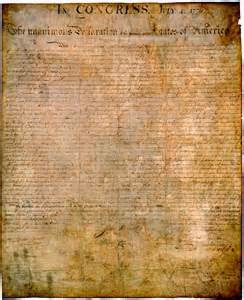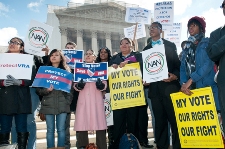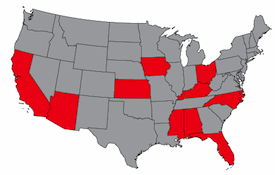Jonathan Turley on 'dangerous' expansion of Obama's powers
Feb. 12, 2014 - 4:48 - Constitutional attorney reacts to the shift of gravity in Washington
The Rise of the Fourth Branch of Government
1, May 26, 2013 by
jonathanturley
Below is today’s column in the Washington Post’s Outlook Section on
the dangers of America’s growing administrative state. Ask any
elementary student and you will hear how the Framers carefully designed a
tripartite, or three-branch, system to govern the United States. This
separation of powers was meant to protect citizens from tyranny by
making every branch dependent on each other to carry out the functions
of government. These three branches held together through a type of
outward pressure – each holding the other in place through their
countervailing forces. Add a fourth branch and the structure begins to
collapse. That is precisely what is happening as federal agencies grow
beyond the traditional controls and oversight of the legislative and
executive branches. The question is how a tripartite system can function
as a quadripartite system. The answer, as demonstrated by the last two
decades, is not well. The shift from a tripartite to a quadripartite
system is not the result of simply the growth in the size of the
government. Rather, it is a concern with the degree of independence and
autonomy in the fourth branch that led me to write this column.
There were times this past week when it seemed like the 19th-century
Know-Nothing Party had returned to Washington. President Obama insisted
he knew nothing about major decisions in the State Department, or the
Justice Department, or the Internal Revenue Service. The heads of those
agencies, in turn, insisted they knew nothing about major decisions by
their subordinates. It was as if the government functioned by some
hidden hand.
Clearly, there was a degree of willful blindness in these claims.
However, the suggestion that someone, even the president, is in control
of today’s government may be an illusion.
The growing dominance of the federal government over the states has
obscured more fundamental changes within the federal government itself:
It is not just bigger, it is dangerously off kilter. Our carefully
constructed system of checks and balances is being negated by the rise
of a fourth branch, an administrative state of sprawling departments and
agencies that govern with increasing autonomy and decreasing
transparency.
When James Madison and the other Framers fashioned a new
constitutional structure in the wake of the failure of the Articles of
Confederation they envisioned a vastly different government. Under the
federalism model, states would be the dominant system with most of the
revenue and responsibilities of governance. The federal government was
virtually microsoptic by today’s standards. In 1790, it had just 1,000
nonmilitary workers. In 1962, there were 2,515,000 federal employees.
Today, we have 2,840,000 federal workers in 15 departments, 69 agencies
and 383 nonmilitary sub-agencies. [These numbers can be themselves
misleading since much federal work is now done by contractors as part of
"downsizing" but the work of the agencies has continued to expand.
Moreover, technological advances have increased the reach of this
workforce].
This growth since the founding has led to increasing power and
independence for agencies. The shift of authority has been staggering.
The fourth branch now has a larger practical impact on the lives of
citizens than all the other branches combined.
The rise of the fourth branch has been at the expense of Congress’s
lawmaking authority. In fact, the vast majority of “laws” governing the
United States are not passed by Congress but are issued as regulations,
crafted largely by thousands of unnamed, unreachable bureaucrats. One
study found that in 2007, Congress enacted 138 public laws, while
federal agencies finalized 2,926 rules, including 61 major regulations.
This rulemaking comes with little accountability. It’s often
impossible to know, absent a major scandal, whom to blame for rules that
are abusive or nonsensical. Of course, agencies owe their creation and
underlying legal authority to Congress, and Congress holds the purse
strings. But Capitol Hill’s relatively small staff is incapable of
exerting oversight on more than a small percentage of agency actions.
And the threat of cutting funds is a blunt instrument to control a
massive administrative state — like running a locomotive with an on/off
switch.
The autonomy was magnified when the Supreme Court ruled in 1984 that
agencies are entitled to heavy deference in their interpretations of
laws. The court went even further this past week, ruling that agencies
should get the same heavy deference in determining their own
jurisdictions — a power that was previously believed to rest with
Congress. In his dissent in Arlington v. FCC, Chief Justice John Roberts
warned: “It would be a bit much to describe the result as ‘the very
definition of tyranny,’ but the danger posed by the growing power of the
administrative state cannot be dismissed.”
The judiciary, too, has seen its authority diminished by the rise of
the fourth branch. Under Article III of the Constitution, citizens
facing charges and fines are entitled to due process in our court
system. As the number of federal regulations increased, however,
Congress decided to relieve the judiciary of most regulatory cases and
create administrative courts tied to individual agencies. The result is
that a citizen is 10 times more likely to be tried by an agency than by
an actual court. In a given year, federal judges conduct roughly 95,000
adjudicatory proceedings, including trials, while federal agencies
complete more than 939,000.
These agency proceedings are often mockeries of due process, with
one-sided presumptions and procedural rules favoring the agency. And
agencies increasingly seem to chafe at being denied their judicial
authority. Just ask John E. Brennan. Brennan, a 50-year-old technology
consultant, was charged with disorderly conduct and indecent exposure
when he stripped at Portland International Airport last year in protest
of invasive security measures by the Transportation Security
Administration. He was cleared by a trial judge, who ruled that his
stripping was a form of free speech. The TSA was undeterred. After the
ruling, it pulled Brennan into its own agency courts under
administrative charges.
The rise of the fourth branch has occurred alongside an unprecedented
increase in presidential powers — from the power to determine when to
go to war to the power to decide when it’s reasonable to vaporize a U.S.
citizen in a drone strike. In this new order, information is jealously
guarded and transparency has declined sharply. That trend, in turn, has
given the fourth branch even greater insularity and independence. When
Congress tries to respond to cases of agency abuse, it often finds
officials walled off by claims of expanding executive privilege.
Of course, federal agencies officially report to the White House
under the umbrella of the executive branch. But in practice, the
agencies have evolved into largely independent entities over which the
president has very limited control. Only 1 percent of federal positions
are filled by political appointees, as opposed to career officials, and
on average appointees serve only two years. At an individual level,
career officials are insulated from political pressure by civil service
rules. There are also entire agencies — including the Securities and
Exchange Commission, the Federal Trade Commission and the Federal
Communications Commission — that are protected from White House
interference.
Some agencies have gone so far as to refuse to comply with
presidential orders. For example, in 1992 President George H.W. Bush
ordered the U.S. Postal Service to withdraw a lawsuit against the Postal
Rate Commission, and he threatened to sack members of the Postal
Service’s Board of Governors who denied him. The courts ruled in favor
of the independence of the agency.
It’s a small percentage of agency matters that rise to the level of
presidential notice. The rest remain the sole concern of agency
discretion.
As the power of the fourth branch has grown, conflicts between the
other branches have become more acute. There is no better example than
the fights over presidential appointments.
Wielding its power to confirm, block or deny nominees is one of the
few remaining ways Congress can influence agency policy and get a window
into agency activity. Nominations now commonly trigger congressional
demands for explanations of agencies’ decisions and disclosures of their
documents. And that commonly leads to standoffs with the White House.
Take the fight over Richard Cordray, nominated to serve as the first
director of the Consumer Financial Protection Bureau. Cordray is highly
qualified, but Republican senators oppose the independence of the new
bureau and have questions about its jurisdiction and funding. After
those senators repeatedly blocked the nomination, Obama used a
congressional break in January to make a recess appointment. Since then,
two federal appeals courts have ruled that Obama’s recess appointments
violated the Constitution and usurped congressional authority. While the
fight continues in the Senate, the Obama administration has appealed to
the Supreme Court.
It would be a mistake to dismiss such conflicts as products of our
dysfunctional, partisan times. Today’s political divisions are mild
compared with those in the early republic, as when President Thomas
Jefferson described his predecessor’s tenure as “the reign of the
witches.” Rather, today’s confrontations reflect the serious imbalance
in the system.
The marginalization Congress feels is magnified for citizens, who are
routinely pulled into the vortex of an administrative state that allows
little challenge or appeal. The IRS scandal is the rare case in which
internal agency priorities are forced into the public eye. Most of the
time, such internal policies are hidden from public view and
congressional oversight. While public participation in the promulgation
of new regulations is allowed, and often required, the process is
generally perfunctory and dismissive.
In the new regulatory age, presidents and Congress can still change
the government’s priorities, but the agencies effectively run the show
based on their interpretations and discretion. The rise of this fourth
branch represents perhaps the single greatest change in our system of
government since the founding.
We cannot long protect liberty if our leaders continue to act like mere bystanders to the work of government.
Jonathan Turley is the Shapiro Professor of Public Interest Law at George Washington University.
Washington Post (Sunday) May 26, 2013
[The statistics on the rule-making and agency case figures in the piece came from Anne Joseph O'Connell,
Vacant Offices: Delays In Staffing Top Agency Positions, 82 S. Cal. L. Rev. 913, 923 (2009) ]
Source:
Jonathan Turley
















 Today,
Reps. John Conyers (D-Mich.) and James Sensenbrenner (R-Wis.), with
Sen. Patrick Leahy (D-Vt.) and others, introduced a bill to
Today,
Reps. John Conyers (D-Mich.) and James Sensenbrenner (R-Wis.), with
Sen. Patrick Leahy (D-Vt.) and others, introduced a bill to  Arizona – The
Arizona – The 


